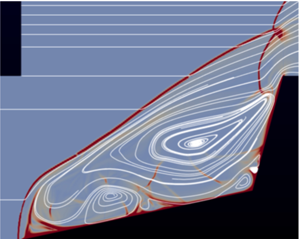Article contents
Unsteadiness boundaries in supersonic flow over double cones
Published online by Cambridge University Press: 06 April 2021
Abstract

A computational parameter study of the viscous axisymmetric supersonic flow over a double cone is made with a view to determining the boundary of the region in which such flows are unsteady. The study is restricted to the case when the boundary layer is laminar. The features of both the steady and unsteady flows in different characteristic regions of the parameter space are described. In particular, the phenomenon of pulsating flow typical of spiked blunt bodies (small first-cone angle,  $\theta _1$, and large second-cone angle,
$\theta _1$, and large second-cone angle,  $\theta _2$), is shown to be inviscid in nature. In
$\theta _2$), is shown to be inviscid in nature. In  $\theta _1$–
$\theta _1$– $\theta _2$ space, the region of unsteady flow is enclosed in a loop with a lower and an upper
$\theta _2$ space, the region of unsteady flow is enclosed in a loop with a lower and an upper  $\theta _2$ branch with a maximum
$\theta _2$ branch with a maximum  $\theta _1$ between. The location of the lower
$\theta _1$ between. The location of the lower  $\theta _2$ branch is determined by the second-cone detachment angle
$\theta _2$ branch is determined by the second-cone detachment angle  $\theta _{2d}$. For this reason, the gas model in one of the conditions is chosen to be thermally perfect carbon dioxide (at Mach number 8) for which
$\theta _{2d}$. For this reason, the gas model in one of the conditions is chosen to be thermally perfect carbon dioxide (at Mach number 8) for which  $\theta _{2d}$ is quite large. In the other cases, the gas model is perfect-gas nitrogen at Mach numbers 2, 4 and 7.7. In the hypersonic range, within the uncertainties, and in the parameter range covered, the unsteadiness boundary is shown to depend on only three dimensionless parameters.
$\theta _{2d}$ is quite large. In the other cases, the gas model is perfect-gas nitrogen at Mach numbers 2, 4 and 7.7. In the hypersonic range, within the uncertainties, and in the parameter range covered, the unsteadiness boundary is shown to depend on only three dimensionless parameters.
- Type
- JFM Papers
- Information
- Copyright
- © The Author(s), 2021. Published by Cambridge University Press
References
REFERENCES
- 12
- Cited by





